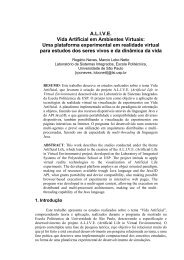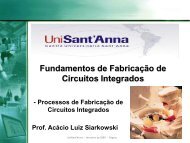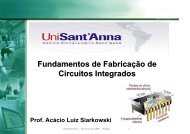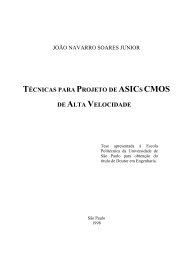Development of a Low Temperature N and P Type TFT's ... - LSI - USP
Development of a Low Temperature N and P Type TFT's ... - LSI - USP
Development of a Low Temperature N and P Type TFT's ... - LSI - USP
You also want an ePaper? Increase the reach of your titles
YUMPU automatically turns print PDFs into web optimized ePapers that Google loves.
The polysilicon layers were deposited in a conventionalhot-wall LPCVD reactor. Silane was used for theundoped silicon film depositions. A mixture <strong>of</strong> silane <strong>and</strong>phosphine or diborane was used to obtain the in-situdoped N <strong>and</strong> P polysilicon layers [6] .A 150 nm thick amorphous silicon layer was depositedby LPCVD at a pressure <strong>and</strong> temperature <strong>of</strong> 90 Pa <strong>and</strong>550°C, respectively.(a)(b)(c)(d)(e)(f)(g)P + poly SiPPPS G Dundoped poly SiAPCVD gate silicon oxidealuminum electrodesisolation: SiO2S G DN + poly SiNNNglass substrateFigure 1: <strong>Low</strong> temperature N <strong>and</strong> P types <strong>TFT's</strong> fabricationprocess using LPCVD <strong>and</strong> SPC techniques. (a) APCVDsilicon oxide <strong>and</strong> poly-Si depositions <strong>and</strong> patterning;(b) silicon oxide P side isolation layer; (c) N+poly-Sideposition <strong>and</strong> patterning; (d) P+poly-Si deposition <strong>and</strong>patterning; (e) source, gate <strong>and</strong> drain patterning; (f) gateoxide deposition, annealing <strong>and</strong> patterning; (g) aluminumdeposition, patterning <strong>and</strong> annealing.amorphous silicon films (undoped, N type <strong>and</strong> P type)structure were solid phase crystallized for 8 hours, at600°C <strong>and</strong> 10 -3 Pa.After SPC process, we performed the patterning <strong>of</strong> the N<strong>and</strong> P type polysilicon layers to define the channel,source <strong>and</strong> drain regions (e). The samples were cleanedusing the st<strong>and</strong>ard RCA procedure followed by a dip indiluted HF, to prepare the surface <strong>of</strong> gate region toreceive the insulator layer. The gate insulator layer is anAPCVD silicon oxide film, 90 nm thick, deposited at450°C. This rather high thickness compared to theprevious studies was chosen to insure electrical results(mainly low leakage current) for the both transistor types<strong>of</strong> this first run. This film was annealed in a conventionalfurnace, at 600°C in nitrogen ambient for 1 hour.The gate insulator layer was patterned <strong>and</strong> the source <strong>and</strong>drain contact regions were opened using buffered oxideetch (BOE) solution (f).Then, a thermal evaporated aluminum layer, 300 nmthick, was deposited <strong>and</strong> patterned by wet etching t<strong>of</strong>orm the electrode contacts <strong>and</strong> interconnections. Finally,the aluminum layer was annealed, in forming-gas, at390°C, during 30 min (g).The electrical characteristics <strong>of</strong> the N <strong>and</strong> P type TFT’sNMOS <strong>and</strong> PMOS inverters were done using aHP 4155B parameter analyzer at room temperature.a. N <strong>Type</strong> TFT’s3. Experimental ResultsFigure 2 shows the transfer characteristics <strong>of</strong> the N type<strong>TFT's</strong>, with width <strong>and</strong> length ratio (W/L) <strong>of</strong>60 µm/23 µm.The drain current, I DS , as a function <strong>of</strong> the gate voltage,V GS , was measured for drain voltage, V DS , <strong>of</strong> 1 V. TheON current, I ON , is due to drain current at a gate voltage<strong>of</strong> 25 V <strong>and</strong> the OFF current, I OFF , is the smallest draincurrent. The threshold voltage was measured by thelinear extrapolation on the gate voltage axis <strong>of</strong> the draincurrent versus the gate voltage I DS (V GS ) transfercharacteristics curve.Table 1 presents the values obtained by the thresholdvoltage (V T ), field effect mobility (µ N ), sub-thresholdslope (S) <strong>and</strong> I ON /I OFF ratio <strong>of</strong> the N type TFT.The undoped amorphous silicon film was patterned <strong>and</strong>plasma etched to define the active layer (a). We used aNextral NE 110 plasma etching system with SF 6 .An APCVD silicon oxide isolation layer, 250 nm thick,was deposited <strong>and</strong> patterned to protect the P side activeregion (b).An in-situ phosphorous doped layer, 150 nm thick, wasdeposited to form the N type <strong>TFT's</strong> (c). The samesequence was used to form the P type <strong>TFT's</strong> (d). These
Table 2: P type TFT’s properties extracted from thetransfer characteristics plots from Figure 3.V T (V) µ P (cm 2 /V.s) S I ON/OFF-13.5 32 -1.3 4 x 10 6Similarly to the N type TFT’s, the threshold voltage <strong>of</strong>the P type <strong>TFT's</strong> are higher than the expected one, due tothe thickness <strong>of</strong> the gate oxide, 90 nm.Figure 2: IDS-VGS characteristics <strong>of</strong> N type <strong>TFT's</strong>(W/L=60µm/23µm) with VDS <strong>of</strong> 1 V.Table 1: N channel <strong>TFT's</strong> properties extracted from thetransfer characteristics plots (Figure 2).V T (V) µ N (cm 2 /V.s) S I ON /I OFF9.6 40 1.3 3 x 10 6c. NMOS InvertersThe measured channel dimensions for the NMOS <strong>and</strong>PMOS inverters were W/L = 15 µm/30 µm <strong>and</strong>W/L = 12 µm/40 µm, for the load <strong>and</strong> drive <strong>TFT's</strong>,respectively.Figure 4 shows transfer characteristics <strong>of</strong> the NMOSinverters, with the power supply voltage (V DD ), as aparameter. The x-axis indicates the input voltage, V IN ,varied from 0 to 20 V <strong>and</strong> the y-axis indicates the outputvoltage, V OUT . The circuit configuration <strong>and</strong> definitions<strong>of</strong> V IN , V OUT <strong>and</strong> V DD are shown in the figure.The high value <strong>of</strong> the threshold voltage obtained can bereduced using a thinner gate oxide [2,9] .b. P type TFT’sFigure 3 shows the transfer characteristics <strong>of</strong> the P typeTFT with width <strong>and</strong> length ratio (W/L) <strong>of</strong> 60 µm/23 µm.The drain current, I DS , as a function <strong>of</strong> the gate voltage,V GS , was measured for drain voltage, V DS, <strong>of</strong> -1 V. TheON current, I ON , due to the drain current at a gate voltage<strong>of</strong> -25 V <strong>and</strong> the OFF current, I OFF , is the smallest draincurrent. An I ON /I OFF ratio higher than 5 x10 6 is suitablefor several types <strong>of</strong> applications in electronic circuits.Table 2 present the values obtained to the thresholdvoltage (V T ), field effect mobility (µ N ), sub-thresholdslope (S) <strong>and</strong> I ON /I OFF ratio <strong>of</strong> the P type TFT.Figure 4: Transfer characteristics <strong>of</strong> NMOS inverters. TheTFT’s dimensions were W/L LOAD = 15 µm/30 µm <strong>and</strong>W/L DRIVE = 12 µm/40 µm.Table 3 shows the inverters properties values extractedfrom Figure 4.Table 3: Output voltage amplitude <strong>and</strong> gain <strong>of</strong> the NMOSinverters.NMOS <strong>TFT's</strong> V DD = 20V V DD = 30VAmplitude (V) 10 V 16.5 VS 1.4 1.7Figure 3: I DS -V GS characteristics <strong>of</strong> P type <strong>TFT's</strong> with V DS asa parameter.To V DD = 20 V, the V OUT value is 11 V to V IN = 0 V, <strong>and</strong>V OUT is 1 V to V IN = 20 V. It means that the outputvoltage amplitude is 10 V or 50 % <strong>of</strong> the applied voltage<strong>and</strong> from the V DD <strong>of</strong> 30 V, the output voltage amplitudeis 16.5 V or 55 %.
The inverters have a practically full rail-to-rail swing,<strong>and</strong> a well-defined voltage transfer characteristics. Thegain presented in Table 3 was measured from the slope <strong>of</strong>the voltage transfer curve in the transition region.Due to the high absolute value <strong>of</strong> threshold voltages <strong>of</strong>the TFT’s, the slopes <strong>of</strong> the transfer characteristics plotare lower than expected.d. PMOS InvertersFigure 5 shows the transfer characteristics <strong>of</strong> the PMOSinverters, with the power supply voltage V SS , as aparameter. The input voltage, V IN , varies from 0 to -25 V<strong>and</strong> is plotted in function <strong>of</strong> the output voltage, V OUT .The circuit configuration <strong>and</strong> definitions <strong>of</strong> V IN , V OUT<strong>and</strong> V SS are shown in the figure.To V SS = -20 V, the V OUT value is -7 V to V IN = 0 V, <strong>and</strong>V OUT is 1 V to V IN = 20 V, which indicates that theoutput voltage amplitude is 6.5 V or 32.5 % <strong>of</strong> theapplied voltage <strong>and</strong> from the V SS <strong>of</strong> -30 V, the outputvoltage amplitude is 13.5 V or 45 %.N <strong>and</strong> P type <strong>TFT's</strong> through the use <strong>of</strong> in situ dopedsource <strong>and</strong> drain polysilicon films. The first run wasprocessed on a silicon substrate with a depositedAPCVD oxide in order to get the same physicalconditions than a glass one. The electricalcharacterizations show the possibility to get N-type <strong>and</strong>P-type inverters. The transfer characteristics, showed inthis paper, are not so good as expected than expected.This is due to the absolute value <strong>of</strong> the threshold voltages<strong>of</strong> the both transistor types that are presently too high.This can be explained by the absence <strong>of</strong> optimization <strong>of</strong>the gate oxide, especially the thickness, which should bedone. A new 6-mask process is currently in progress t<strong>of</strong>abricate basic electrical circuits on glass substrate.Notice that this technology is solid phase crystallizationbased, that means no temperature higher than 600°C,even during crystallization step <strong>and</strong> as publishedpreviously, presents a very high potentialreproducibility [2,7] .AcknowledgmentsThe authors are grateful to Ph. Cullerier <strong>and</strong> R. Rogel,for polycrystalline silicon deposition <strong>and</strong> for their help inthe fabrication process. The authors want also to thankDr. Y. Helen <strong>and</strong> Pr<strong>of</strong>. T. Mohammed-Brahim for helpfuldiscussions <strong>and</strong> advice about the fabrication process.Financial support from CNRS, ALFA program, FAPESP,CAPES/COFECUB, CNPq <strong>and</strong> FINEP are gratefullyacknowledged.ReferencesFigure 5: Transfer characteristics <strong>of</strong> PMOS inverters. TheTFT’s dimensions were W/L LOAD = 15 µm/30 µm <strong>and</strong>W/L DRIVE = 12 µm/40 µm.Table 4 presents the amplitude <strong>and</strong> the subtreshold slopeextracted from Figure 5.Table 4: Output voltage amplitude <strong>and</strong> gain <strong>of</strong> the PMOSinverters.PMOS <strong>TFT's</strong> V SS = -20V V SS = -30VAmplitude (V) 6.5 V 13.5 VS -1.2 -2.0Let us notice that we observed the similar behavior to theN type inverters.4. Discussion <strong>and</strong> ConclusionWe have developed a low temperature process (< 600°C)to fabricate simultaneously, on the same glass substrate,[1] C. T. Angelis, C. A. Dimitriadis, M. Miyasaka, F. V.Farmakis, G. Kamarinos, J. Brini, J. Stoemenos, " Effect <strong>of</strong>excimer laser annealing on the structural <strong>and</strong> electricalproperties <strong>of</strong> polycrystalline silicon thin-film transistors".Journal <strong>of</strong> applied physics, vol. 86, n.8, October, 1999,pp. 4600-4606.[2] K. Mourgues, F. Raoult, T. Mohammed-Brahim, D. Bri<strong>and</strong>,O. Bonnaud, "Performance <strong>of</strong> thin film transistors onunhydrogenated in-situ doped polysilicon films obtainedby solid phase crystallization", Mat. Res. Soc. Symp. Proc.,vol. 471, 1997, pp. 155-160.[3] K. J. Nieuwesteeg, A. H. van Ommen, "AM-LCD's bringsolid-state devices to the display". Proceedings <strong>of</strong> the 27thEuropean Solid-State Device Research Conference,ESSDERC'97, Stuttgart, Germany, 22-24 Sept, pp. 88-100,1997.[4] S. D. Brotherton, J. R. Ayres, M. J. Edwards, C. A. Fisher,C. Glaiser, J. P. Gowers, D. J. McCulloch, M. Trainor"Laser crystallized poly-Si <strong>TFT's</strong> for AMLCD's". ThinFilms for Large Area Electronics, European MaterialsResearch Society, E-MRS, Thin Solid Films, SymposiaProceedings, vol. 80, pp. 188-195, 1999.
[5] S. Chopra, R. S. Gupta, " Subthreshold conduction inshort-channel polycrystalline-silicon thin-film transistors".Semicond. Sci. Technol, vol. 15, pp. 197–202, 2000.[6] D. Bri<strong>and</strong>, M. Sarret, P. Duverneuil, T.Mohammed-Brahim <strong>and</strong> K. Kis-Sion, "Influence <strong>of</strong> thedoping gas on the axial uniformity <strong>of</strong> the growth rate <strong>and</strong>the electrical properties <strong>of</strong> LPCVD in-situ dopedpolysilicon layers", J. Phys. IV, vol. 5, pp. 887, 1995.[7] A. Rahal, T. Mohammed-Brahim, H. Toutah, B. Tala-Ighil,Y. Helen, C. Prat, F. Raoult, "Ageing <strong>of</strong> laser crystallized<strong>and</strong> Unhydrogenated polysilicon thin film transistors".Elsevier Science, Microelectronics Reliability, vol. 39,pp. 851-855, 1999.[8] O. Bonnaud, "Polycrystalline silicon thin film transistors:state <strong>of</strong> the art <strong>and</strong> improvement <strong>of</strong> electricalcharacteristics". Solid state Phenomena, vol. 67-68,pp. 529-540, Scitec Publications, Switzerl<strong>and</strong>, 1999.[9] Y. Helen, R. Dassow, K. Mourgues, O. Bonnaud, T.Mohammed-Brahim, F. Raoult, J. R. Koehler, J. H.Werner, D. Lemoine, "Reproducible high field effectmobility polysilicon thin film transistors involving pulsedNd:YVO 4 laser crystallization". IEDM, InternationalElectron Devices Meeting 1999, Washington D. C.,pp. 297, 1999.
















